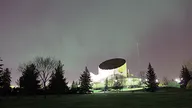The Visible Planets
Mercury is found low above the western horizon at sunset at the start of the month, but by April 8, it disappears into the Sun’s setting glow. It is at inferior conjunction (between the Sun and the Earth) on April 11. By the end of the month, Mercury slowly reappears low above the eastern horizon before sunrise but will be difficult to see with the brightening sky.
Venus disappears into the glare of the rising Sun by the end of the month but can be seen with some difficultly low above the eastern horizon before sunrise before then. Before sunrise on April 24, look for a parade of planets low above the eastern horizon. Venus will be the brightest planet found near the horizon, with the other planets Mercury, Neptune (not visible to the unaided eye), Mars and then Saturn fanning out above the southeastern horizon. All planets may be difficult to see with the brightening sky.
Mars is found low above the east-southeast horizon prior to sunrise. On April 6, look for Mars just above the waning crescent Moon and the planet Saturn. Binoculars will greatly help you seeing this conjunction of the Moon with planets Mars and Saturn, as they will be within the dawn’s early glow. On April 10, use binoculars to see a close conjunction of Mars with the planet Saturn low in the east-southeastern sky before sunrise. On April 24, Mars transitions into the adjacent zodiac constellation of Pisces, the fish, from the constellation of Aquarius, the water bearer.
Jupiter is found shining brightly above western horizon at sunset at the start of the month. As the month progresses, Jupiter sinks lower toward the western horizon in the early evening sky. By the end of the month, Jupiter is ready to descend in the sunset glow, and will soon disappear from the evening sky in early May. On April 27, Jupiter moves from the constellation of Aries, the ram, into the adjacent zodiac constellation of Taurus, the bull. On April 10, look for Jupiter just below the slim waxing crescent Moon. On April 20, see if you can find the faint planet Uranus near Jupiter using binoculars or a small telescope.
Saturn is starting to move out dawn’s early light, low along the east-southeast horizon at the start of the month. On the morning of April 16, look for Saturn above the very shallow crescent Moon above the east-southeast horizon. Saturn will be situated within the constellation of Aquarius, the water bearer.
Moon Phases
April 1 Last Quarter Moon
April 8 New Moon (solar eclipse)
April 15 First Quarter Moon
April 23 Full Moon (Pink Moon)
Special Events
International Space Station (ISS) Observable Passes
Look for passes of the ISS before sunrise in the early morning sky from April 24 through the rest of the month. Exact times of these passages for your location can be found by visiting the website http://www.heavens-above.com or by using satellite tracking smart phone apps like Sputnik or Spot-the-Station.
April 1-12 Comet 12P/Pons-Brooks may become visible in our western evening sky with binoculars.
April 8 Partial solar eclipse visible from Alberta (Total Solar Eclipse from parts of Eastern Canada, USA, and Mexico)
Partial Solar Eclipse Times for Edmonton:
Eclipse Begins: 11:54 a.m. MST
Mid-Eclipse: 12:46 p.m. MST - 34% eclipse magnitude (sun’s diameter), 23% of the area of the Sun covered by the Moon
Eclipse Ends: 1:39 p.m. MST
Eclipse duration: 1 hour and 45 minutes
Safe solar filters are required to view this partial solar eclipse.
Safe eclipse viewing glasses will be sold in the Galaxy Gift Shop at TELUS World of Science – Edmonton.
The RASC Observatory will be open, weather permitting, from 11:30 a.m. to 2:00 pm MST to view the eclipse safely though proper solar telescopes.
For areas in eastern Canada along the total solar eclipse path and anyone else at other locations where the total solar eclipse can be viewed, viewers in those areas may also see a comet, 12P/Pons-Brooks, become visible in the sky during totality.
April 14 Boeing’s Starliner first crewed (Butch Wilmore and Suni Williams) test flight to the International Space Station.
April 15 Royal Astronomical Society of Canada (RASC) Edmonton Centre meeting. Live in the Zeidler Dome and presented virtually through Zoom from 7:30 p.m. – 9:30 p.m. Free for anyone to attend.
See http://www.edmontonrasc.com for more details.
April 20 Conjunction of Jupiter with much fainter planet Uranus (30-minutes of arc of separation).
April 22 The Lyrid meteor shower peaks (Zenith hourly rate of only 18).





